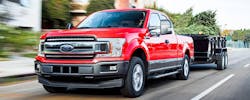Diesel power has been proven for more than a century, dominating markets with challenging fuel prices and emissions requirements. The US Department of Energy reported, “In 2011, diesel car sales made up 51.8 percent of the European market.” Maserati’s Harald Wester added that in 2013, “Diesel engine[s] represent 75 percent of the large-car segment in Europe.”
One US manufacturer’s blunder scarred the US automotive diesel market. In the late 1970s, GM responded to the fuel crisis by attempting to convert a 350 cubic-inch V8 gasoline engine to diesel. GM installed this conversion attempt in Chevrolet, Buick, Pontiac, Oldsmobile and Cadillac cars, along with Chevrolet and GMC pickups. Many failed.
A New York Times article’s title declared, “G.M.’s Dreadful Engines Gave Diesels a Bad Name.” And a Popular Mechanics article reported, “The engines were so bad, they spurred legislators in several states to draft early lemon laws. In the long run, they ruined the American consumer’s appetite for diesels.”
Fast-forward 40 years, and diesels are making a comeback in America. They’ve long been used in the agricultural and over-the-road trucking industries, but there is a renewed interest in diesel power in the United States.
There has long been American mania for trucks, according to Automotive News. The Ford F-150 pickup truck has been the best-selling US vehicle for 40 years. Diesel power finds a responsive market in pickup trucks. Especially with yesterday’s sluggish, shaking, smoke-belching diesels replaced by today’s smooth diesel power and performance. These improvements also apply to passenger car diesel engines. Test drive participants experience smooth race-winning performance and ask, “Is this really a diesel?”
Diesels may also be the answer to today’s regulatory red tape. Automakers believe the diesel engine can meet emissions and CAFE “requirements at a lower cost than either hybrid or plug-in systems” while also coming to market more quickly, according to Green Car Reports.
Big Three Update
Ford
Henry Ford wanted to help address farm labor. Raised on a farm with, “One foot in industry, and one foot in the soil. I have followed many a weary mile behind a plow, and I know all the drudgery of it.”In the early 1900s, Ford’s US shareholders wanted to continue to focus on automobiles. Ford created the Henry Ford and Son Company and began working with the UK’s Perkins to produce diesel farm tractors. (Only the nutshell here, as Henry Ford and Son’s Fordson became, at one time, the world’s most popular farm tractor. Manufactured in the US, England and Ireland, Fordson production included both diesel and gasoline engines, along with war-support tractors and trucks.)
Recently, Ford Motor Company invested in a diesel option for its F-150 pickup. One has to ask how much of this was due to problems with gasoline-fueled EcoBoost engines? When asked, Ford spokesman Mike Levine supported the EcoBoost platform but added, “diesel is a solution.” Now, Ford F-150 pickup options include a Lion Series diesel engine manufactured at Ford’s British Dagenham Diesel Centre. This engine has been proven in Jaguars, Land Rovers, Peugeot Citroëns and Aussie Ford SUVs. With modifications for the F-150 pickup truck, Ford offers the 3.0L Power Stroke, a lightweight V6 diesel engine producing 250 horsepower at 3,250 RPMs and 440 pound-feet of torque at 1,750 RPMs. (Fig. 1)
Chrysler’s Ram Trucks
Chrysler, owned by Euro registered Fiat Chrysler Automobiles’ (FCA) Fiat Automotive Group, is a major American automobile manufacturer selling under the Chrysler brand, along with Dodge, Jeep, Mopar and Ram Trucks.Ram Truck’s chief engineer Mike Cairns observed, “For years we have had customers asking, why not a light-duty diesel? There is a lot of interest. People know they will get great fuel economy, great durability and reliability with a diesel.”
Cummins rules the Ram Trucks heavy-duty diesel engine market. However, FCA owns both Ram Trucks and VM Motori, a lightweight performance diesel engine manufacturer based in Cento, Italy, with Maserati and Ferrari design connections. VM Motori produces diesel engines that have been proven for 40 years in marine applications, plus contracts to supply Maserati, Ferrari and Alfa Romeo cars, as well as Jeep Grand Cherokees and Chrysler Voyagers, while meeting Euro emissions standards.
In 2014, Ram introduced its 3.0L EcoDiesel as an option on the 1500 pickup truck — a lightweight VM Motori engine with European-bred diesel fuel efficiency, smooth power and durability. (Fig. 2) In 2014, USA Today reported, “Consumer Reports crowns Ram diesel as best pickup.” And WardsAuto announced the EcoDiesel as one of the “smoothest, quietest” diesels tested. Shortly after, EcoDiesel orders challenged production.
Ironically, GM’s loss became Ram’s gain. GM once owned 50 percent of VM Motori, but the 2009 bankruptcy court-ordered a recovery sale of foreign ownerships. This opened the door for FCA. Following its VM Motori purchase from GM, FCA brought a former Cadillac diesel engine to completion as the 3.0L EcoDiesel now offered in the Ram 1500, according to WardsAuto. Orders for the award-winning EcoDiesel, providing 240 horsepower at 3,600 RPMs and 420 pound-feet of torque at 2,000 RPMs, represented one-in-five of Ram 1500 sales.
With an FCA 3.0L V6 diesel engine co-developed between the Ferrari and Maserati teams already available in Chrysler’s Jeep Grand Cherokee, CarScoops said to stay tuned for a diesel to make an appearance in the Chrysler 300.
General Motors
Not to be outdone, in 2015, GM (former owner of VM Motori before selling to FCA) introduced pickups with GM’s new lightweight 2.8L Duramax diesel engine, offering 181 horsepower at 3,400 RPMs and 369 pound-feet of torque at 2,000 RPMs. (Fig. 3)GM is stepping carefully in memory of their gasoline-to-diesel conversion blunder. “Cadillac is working on four- and six-cylinder diesel engines … [Cadillac’s recent President Johan] De Nysschen is optimistic about the prospects for the diesel engine, even though he acknowledges that ‘the reputation has no doubt suffered a bit,’” Car and Driver reported.
Part of De Nysschen’s incentive likely came when the 3.0L VM Motori diesel designed for his Cadillac CTS — lightweight and powerful while meeting Euro emissions requirements — began competing against GM’s emissions-challenged 4.5L Duramax in 2011. Stay tuned for Cadillac’s diesel recovery.
A Diesel Tech Breakthrough
Newly-arrived reports from Automotive News and Motor Trend indicate, “Robert Bosch GmbH claims to have developed an exhaust system that reduces diesel emissions to a tenth of the legal limit.”Reports indicate this potential breakthrough in toxic exhaust reduction could secure diesel power in vehicles worldwide. Technical details include a paper detailing how Bosch tested the system, available for download from Automotive News (or by emailing me at: [email protected]).
This paper concludes Bosch’s test, implementing real driving emissions (RDE) requirements, including traffic-jam conditions, with heady words: “The diesel-based powertrain has thus proved to be a future-proof solution for the entire mobility mix of the future.”
Shop Owner Priorities
Prudent shop owners follow the money — vehicle manufacturer investments. As use of Bosch’s technology matures, more vehicle owners will turn to diesel power and seek their best return on investment (ROI) for engine maintenance.Be thinking about where your shop should invest for training and inventory as more and more diesels roll through your bays. Most techs already understand internal combustion, a training curve advantage for diesel engine maintenance and repair. Be sure you have knowledge of and access to preventive maintenance inventory for diesel fuel systems. According to SAE paper 2002-01-2659, “Deposits [are] regarded among the most notable and critical of [diesel engine design] characteristics.”
As the big three embrace diesel power and technology breakthroughs make diesels more efficient, you’ll want to be in the driver’s seat, helping your customers get the best ROI out of their diesel powered vehicles by offering them the preventive maintenance they need.
About the Author

